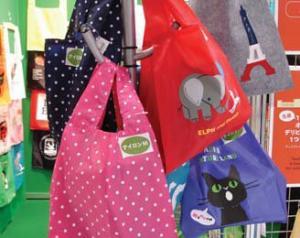Business Break & Trends in Japan
Business Break
By Greg Lane
 Mobile Moves
Mobile Moves
While SoftBank seems to be winning the battle for new subscribers in the saturated mobile phone market, niche player Emobile—which launched in spring 2007—looks to be making steady progress. The “Mobile Broadband” provider signed up a record number of new subscribers in December. Although the numbers are still tiny compared to the big three of NTT DoCoMo, AU and SoftBank, Emobile’s 41,000 new subscribers represent an 8% share of new subscriptions. An attractive sub ¥10,000 PDA Phone promotion through January and a 7.2Mbps PCMCIA card (twice the speed of offerings from the other carriers) released in February should see a strong boost in growth.

Second Life
If you thought mobile phone users weren’t engrossed enough in their hand sets as it was, thanks to a platform developed by SUN—a Tokyo based firm specializing in mobile content delivery—there may be even more commuters forgetting to get off at their station. Since February, DoCoMo subscribers with a sufficiently up-to-date handset have been able to access ‘virtual world’ Second Life from their mobile handsets. Despite reports of a slow down in growth of Second Life, this signals a major step forward in mobile functionality and should contribute to quite a few more data packets over the DoCoMo network.

Breakthrough for Skype
VOIP (Voice Over Internet Protocol) service Skype should receive a significant boost in the Japanese market with Sony providing PSP (their handheld games console) users with a software update to allow users to run the popular peer-to-peer software. A subsidiary of eBay, Skype has so far failed to deliver the same level of hype in Japan that it has in Europe and North America. This should also provide a boost to the PSP in its battle with Nintendo’s popular DS.

Web 2.0
Omnipresent (at least on the interwebs) entrepreneur and early stage investor Joi Ito announced that his company Digital Garage would be bringing Web 2.0 phenomenon Twitter to Japan. The social networking ‘micro-blogging’ service allows users to keep in constant touch with friends and family. The site is particularly known for its integration with email texting from cell phones. It will be interesting to see if Ito can get a major Japanese mobile carrier onboard. The development team has already announced that getting a mobile version up and running will be a priority. With the Disney–SoftBank MVNO as well, Web 2.0 in Japan looks to be gravitating more and more towards the wireless sector.

The sun setting on DRM?
While not specifically mentioning Japan, Amazon.com announced in January that they would be launching their Digital Rights Management (DRM)-free download service ‘Amazon mp3’ worldwide by the end of 2008. Amazon mp3 includes DRMfree downloads from the big four record companies—Sony BMG being the last to come on board in January this year. It will be interesting to see if this will actually extend to Japan and if Amazon and iTunes (with a limited catalogue of DRMfree offerings) will have the clout to convince the other DRM obsessed Japanese record companies to release their tracks. Probably not though.

Power from footsteps
The Asahi Shimbun reports that JR East began an experiment this year to generate electricity from the pressure of commuters’ footsteps as they pass through ticket wickets. Covering an area of 90 square meters adjacent to the Yaesu entrance of Tokyo Station, a single commuter passing through the gates will generate enough electricity to power a 100 watt light bulb for 0.01 seconds! A continuation of experiments begun in 2006, and the latest mat boasts an efficiency increase of 1,000% over previous systems. According to a JR spokesperson, a further 10-fold increase in efficiency will be required before the system will actually be useful.JI
If you have any news on new business, tech, start-ups or spin-offs, please contact Greg Lane at greg@quiva.net.
New business & IPO
IPOs scheduled for January and February were for the most part fairly unremarkable with the notable exception of Seven Bank. Originally known as IY Bank, the major shareholders prior to IPO were ‘7 and I’ Holdings with approximately 25% and Ito Yokado with about 15%. Since its establishment in 2001, the bank has achieved strong growth with deposits in 2007 reaching a total of ¥211 billion.
Award for the most interesting Japanese IPO of the year to date goes to a company that didn’t even list in Japan. January 16 saw the listing of Japan Leisure Hotels Ltd on the Alternative Investments Market of the London Stock Exchange. On listing, JLH took control of a portfolio of love hotels assembled by YK New Perspective, who will continue as asset managers. With the IPO raising almost US$6 million (¥639 million) the new entity has a market cap of US$42.8 million (¥4.6 billion). New Perspective is looking to acquire more hotels then refurbish and re-brand under its ‘Bonita’ moniker.
Trends in Japan
Eco fashion

Tokyo teen fashion Mecca, Shibuya, is having an unusual bohemian moment. Take a stroll through the trendy Shibuya 109 fashion building and you’ll see many a boutique offering ’60s-inspired flower-print dresses with flowing skirts and sleeves and fringed suede boots and vests.
These trappings of hippie-dom are not without a message. One shop window appeals, ‘Open your conscious, live the hippie life’ while another T-shirt proclaims ‘No Ego, Yes Eco,’—there’s even one commanding you to ‘Change your shoes!’ Clearly, the flower power trend is in vogue this season.
While the Lifestyles of Health and Sustainability (LOHAS) movement has won over a fair number of consumers in Japan, they tend to be from an older, alternative crowd. Eco-consciousness has so far failed to impress the mainstream legions of shop–happy teens and young adults who tend to make emotional purchases often based on cuteness. LOHAS just wasn’t speaking their language.
Then came the eco-bag. One of the most successful products in 2007, according to the Nikkei Marketing Journal, the eco-bag makes an earth-friendly fashion statement. With the frenzy created by the release of Anya Hindemarch’s “I am not a plastic bag,” the most sought-after eco-bag ever, and Susan Bijl receiving a coveted design award from the Japan Industrial Design Promotion Organization for her twotone nylon shopping bags, the media is pushing consumers to buy into the ecofashion boom.

Seeing a hot item with the potential for a remake, many labels have launched their own versions, like Love Boat’s pastel cloth bags with ‘Girls Save the Earth’ scrawled across the front. The shop girls tell us these decidedly cute bags are selling fast, although how many eco-bags you can own before they cease to be environmentally friendly? That said, it seems that some real steps towards eco-consciousness are being made. Popular chain Love Girls Market, is going a step further by giving a ¥50 (US$0.45) discount for customers who bring their own bags. Its own eco-bag is notably made from 100% organic cotton, marking perhaps the first time the word organic has appeared in the likes of Shibuya 109 in a meaningful way.
So, is it possible that Tokyo’s notorious young materialists are buying into this Earth-girl image? Yes, so long as it’s cute, of course.JI
Rebecca Milner, Trend Consultant, Cscout Japan
Cscout Japan is part of the global Cscout research, trend scouting, and Experience Tour network, focused on all segments of the deep and rapidly changing Japanese market landscape. Its popular daily blog can be found at www.CscoutJapan.com





